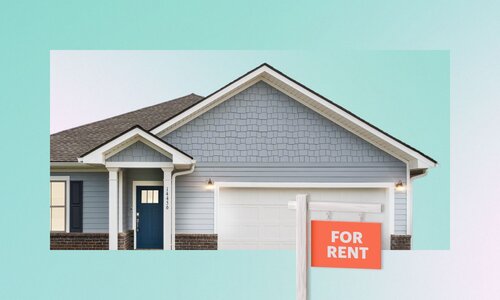It used to be that if you were looking for an affordable mortgage with a lower monthly bill, a balloon mortgage was a popular option to consider.
Balloon mortgages were very common in mortgage lending in the mid-to-late 2000s, before the financial crash and the Great Recession of 2008. For a small initial payment, buyers could get a mortgage that would have small or interest-only payments at the beginning of the mortgage term, with larger and larger payments towards the end, with the final balloon payment repaying the loan in full, and often being as much as double the mortgage’s average monthly payment. Buyers would plan to refinance the mortgage before the final payment came due, but during the financial crisis of 2008, many were unable to do so, which meant large numbers of people went into mortgage default.
While balloon mortgages are not as common today, they are still available. Here’s everything you need to know about balloon mortgages and the pros and cons of having one.
What is a balloon mortgage?
A balloon mortgage is a type of home loan in which the borrower makes small or no payments for the early years of a mortgage, typically five to seven years, after which they pay a lump sum—called a balloon payment—to pay off the loan in its entirety. The initial payments typically go towards interest, and the final payment is generally more than two times the monthly payment, according to data from the Consumer Financial Protection Bureau. The final payment can be thousands or even tens of thousands of dollars, depending on how the mortgage is structured.
The specific terms of a balloon mortgage will depend on the lender and the loan, and you can choose either a fixed-rate or adjustable-rate mortgage. Balloon mortgages tend to have shorter terms, between five to ten years. The initial payments in a balloon mortgage are typically small because they’re not fully amortized, and the payments during the fixed period may be interest only.
Balloon mortgages are popular with house flippers, who finance homes they expect to resell in a very short period. The proceeds from the sale can then be used to make the balloon payment. While advantageous in the short-term, balloon payment mortgages are considered extremely risky for everyday or first-time homebuyers and lenders.
The difference between balloon mortgages and traditional mortgages
The primary difference between a balloon mortgage and a conventional mortgage is the payment structure and how the loan’s principal balance is paid off. A traditional mortgage is fully amortized, meaning that each mortgage payment pays off both the principal and the interest, with the earlier payments paying off more than the principal and the final payments being entirely principal. This mortgage payment stays relatively stable through the loan term and helps pay off the total amount by the end of the loan term.
Balloon payment amortization, however, works differently. The initial payments don’t cover the total amount of the principal or sometimes even the interest that would be necessary to pay off the loan at the end of the mortgage term. While this means lower payments in the early years, it leads to the final few payments ballooning up—hence the term—to create a very large payment due at the end of the loan.
Since they’re riskier, balloon mortgages tend to come with higher interest rates than traditional fixed-rate or adjustable-rate mortgages and are offered by small or private lenders or for certain types of lending, such as in construction.
How balloon mortgages are structured
How your mortgage will be structured will depend on your lender and the type of loan. Here’s what you can expect:
- Interest-only payments: In this payment structure, you only pay interest for an initial period of the loan, with no money going toward the principal. Once that initial term period is over, you owe the remaining balance of the loan, that is, the entire principal. This payment structure can result in tens of thousands of dollars being owed to the lender for the last payment.
- Balloon payment: There are a few ways a balloon payment can work, the most common being structuring the mortgage on a traditional 15-year or 30-year amortization schedule. The loan itself would only be for five to seven years, however, so you’d pay the mortgage payments monthly as with a traditional loan and then owe the remaining loan balance at the end of that term. You can use an online balloon mortgage calculator to run the numbers on your mortgage and see what your final bill will look like.
- No payment: When a balloon mortgage’s payment schedule is structured this way, the borrower makes no monthly mortgage payments for a short term, after which the interest and principal are due in one substantial payment.
Pros and cons of balloon mortgages
There is no question that balloon mortgages can be risky for both the borrower and the lender. Before you agree to a balloon mortgage, consider the pros and cons of taking one out.
Pros
- Low monthly payments: With a balloon mortgage, you pay very little in the early years of the mortgage. With interest-only payments, you’d only be paying the principal, and some mortgages are structured in a way that you’d pay nothing at all. These lower monthly payments can make home ownership affordable for many.
- Get on the property ladder: Because of this lower outlay, a balloon mortgage can make it easier for people who don’t have large cash savings or cash flow to own a home more easily.
- Deferred payments: While the full balance of the loan will come up for repayment after the mortgage term is up, some lenders may allow you to defer that payment. You can also refinance your mortgage before the payment comes due, a strategy many homebuyers use to purchase their first property.
- Ideal for flips: Balloon mortgages can be a good loan option for real estate investors who want to invest in commercial real estate or flip properties but have little or no cash to start with. Since there is no prepayment penalty on balloon mortgages, most investors will pay off the mortgage using the funds from the sale of the refurbished property.
Cons:
- Risky investment: The biggest disadvantage of taking out a balloon mortgage loan is that it puts you at great financial risk. Even if you have a plan for refinancing or selling the home before the lump sum payment comes due, a market crash, a drop in home values, or an unforeseen personal finance difficulty could prevent you from paying the balance, going into foreclosure, and losing your home.
- Difficult to find: Since 2008, after the financial crash, the ensuing Great Depression, and the change of laws, balloon mortgages have become harder to find. Most well-known mortgage lenders no longer offer balloon mortgages.
- Higher interest rates: Due to the risky nature of balloon loans, they come with higher interest rates, which means you’re paying more than you would for a conventional mortgage or any type of mortgage offered by the FHA, VA, or USDA.
- Lower equity: With a balloon mortgage, you’re paying little to no money towards your principal, which means you’ll build equity in your home slowly. This can make refinancing difficult since you’ll typically require at least 20% equity in your home for a successful refinance.
Paying off a balloon mortgage
If you want to pay off a balloon mortgage, you have three options:
- Pay it: If you’ve been building up savings, have an expected windfall (sale of a different property, inheritance, pension maturity), or have the cash in the bank to afford this option, simply pay off the remaining balance to settle it.
- Refinance it: This is a more difficult option since you will need to own some equity in the home. However, if you can get a more conventional fixed-rate mortgage, you can use the new loan to pay off the balloon mortgage. You will need a steady income and a good credit score for a refinance. You will also need to pay additional closing costs.
- Sell it: You can also sell the home and pay off the balloon mortgage using the proceeds from the sale of the home. This is typically the strategy house flippers opt for, and it’s also a good option if you’re only planning on being in a home for a few years.
The bottom line
A balloon mortgage can be a good option for investors who want to start investing in real estate but have no spare cash. That said, while there are advantages to a balloon loan, it does come with a large risk that can be financially devastating if things go wrong.
If you’re interested in investing in real estate without the risk, purchasing shares in a home may be the right option. At Arrived, we help real estate investors achieve cash flow and property appreciation by purchasing shares in profitable rental properties. Through our platform, you can purchase shares of rental properties for as little as $100 and start building a portfolio—and a rental income—today. Please browse through our available properties here.







